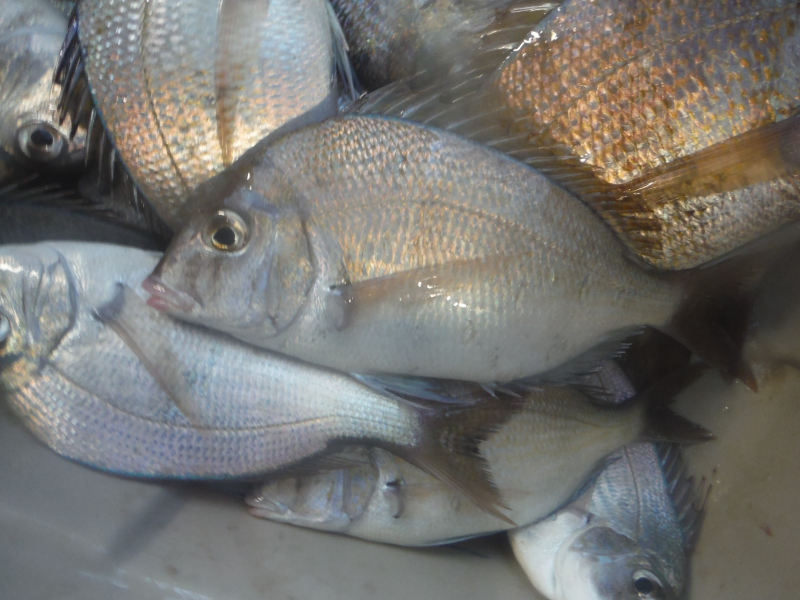Commercial scup, or porgy, landings peaked in 1981 at 21.73 million pounds but dipped to 2.66 million pounds by 2000. In recent years, commercial fishermen have not landed the commercial quota, and there have been industry-wide efforts focused on closing the gap.
The commercial fishery is year-round, and mostly in federal waters during the winter and state waters during the summer. A coastwide commercial quota is allocated between three quota periods: winter I, summer and winter II. Total ex-vessel value in 2018 was $9.70 million, resulting in an average price per pound of $0.73. NOAA data shows landings from October to the end of December 2020 are below last year’s landings.
Despite being highly abundant, and not considered overfished, the industry has grappled with achieving a harvest of the full quota every year, in part because commercial fishermen often do not fish for scup when the dock price is depressed. If market demand were increased, prices and opportunities for fleets to harvest the fish would follow.
Dave Aripotch, a commercial scup commercial fisherman in Montauk, N.Y., says 2020 was decent, but that he pulled in less volume than previous years.
“A lot of times with scup, if you catch them, you catch a lot of them. This year, there were a lot of small and mediums around, and this means the market gets plugged even for jumbo.”
Aripotch has fished since 1982, and most of his scup ends up in New York City and at the New Fulton Fish Market there in Hunts Point. He has seen fluctuations over the years.
“A few years ago, scup was booming — we caught a huge amount of them, but there were fewer guys doing it.” He says in 1985, jumbos were worth $3. “Now, we get $2 for jumbo, and jumbos were $1 or 75-65 cents at times.” Aripotch says in his area, a lot hinges on squid, since given the opportunity, many fishermen switch over to squid and move off scup.
The covid-19 pandemic added another layer. Freeman Wong of Aqua Best Seafood, a family-owned business in New York City’s Lower East Side and with locations in Massachusetts, says scup is a popular staple item for Caribbean restaurants who fry it whole.
“This year, it’s hard to say on scup because everything is out of the norm. Throughout the pandemic, the retail market was open, but I think that the porgy market by itself is always impacted by other fish that are more abundant,” Wong says. He says prices this year were, overall, similar to previous years, and recently on the Aqua Best Seafood website scup were going for $4.99 a pound.
“This pandemic has screwed up our timing, but we’ve been working hard,” says Scott Bode, of Pier Fish, a large processor and distributor in New Bedford, Mass. “This year has been slow for scup, and prices have been higher, due to lack of fishing. The boats aren’t going after it, that’s the biggest thing. People are focused on the species that make them money.”
Fish like fluke that are likely to be bought in the retail settings have fared a bit better than species like scup that require more preparation or knowledge before at-home cooks are comfortable with it.
Meghan Lapp, general manager of Seafreeze Shoreside in Point Judith, R.I., says scup markets had volatility, even before the pandemic.
“For scup, it’s par for the course. In the past number of years, prices fluctuated between 20 cents and $1.50 a pound, and that’s not unique to now.” She attributes some loss of market interest in scup to a generation of immigrants getting older and younger Americans eating less whole fish. “But I feel like millennials are a really good market to target this to,” she adds. ”They are now more inclined to try something they haven’t tried before.”
Bode and Lapp both say they remain hopeful that scup can move beyond its status as an underutilized species — and to that end, both have participated in industry initiatives looking to expand markets for scup. One of those initiatives is with the Commercial Fisheries Research Foundation, based in Rhode Island, a collaboration of scup fishermen, scientists, processors and chefs.
“Our projects have all tried to increase consumer and public awareness of scup and increase the processing efficiency and capacity for local markets, which in turn will hopefully lead to increased market demand and increased value back to the boats and fishermen who land scup,” says Michael Long, a research biologist at the foundation.
But processing remains a major challenge for scup, says Long.
“Their small size, pin bones, and fat lines have definitely given us plenty of challenges with processing,” he says. “One full project was dedicated to testing processing techniques and involved shipping whole scup from Rhode Island to Michigan to get filleted by a salmon processor who could remove their pin bones, then they were shipped back to Rhode Island for us to conduct culinary evaluations!” Since then, the initiative has shifted processing trials to a local Rhode Island-based company.
Long says the upside of the initiative is that culinary trials reveal the general public and chefs like the taste of scup.
“There’s a lot of room for growth. It’s not going to be as cheap as we wanted it to be, but we are working it out,” says Bode.
“I’m always optimistic,” adds Lapp, “but I think it’s going to take some effort on behalf of marketing for a wider audience. If there was a targeted campaign, you know, “It’s a poor man’s snapper, try this!”
Fisherman Dave Aripotch agrees. “Scup is excellent; there is plenty of it. We have people in Montauk who’ve lived here their whole lives — have never even tried it!”







